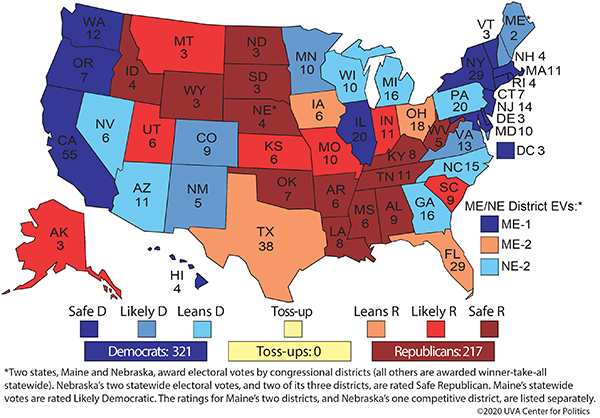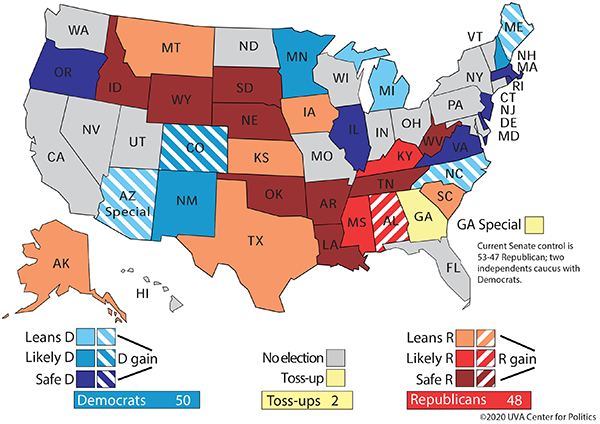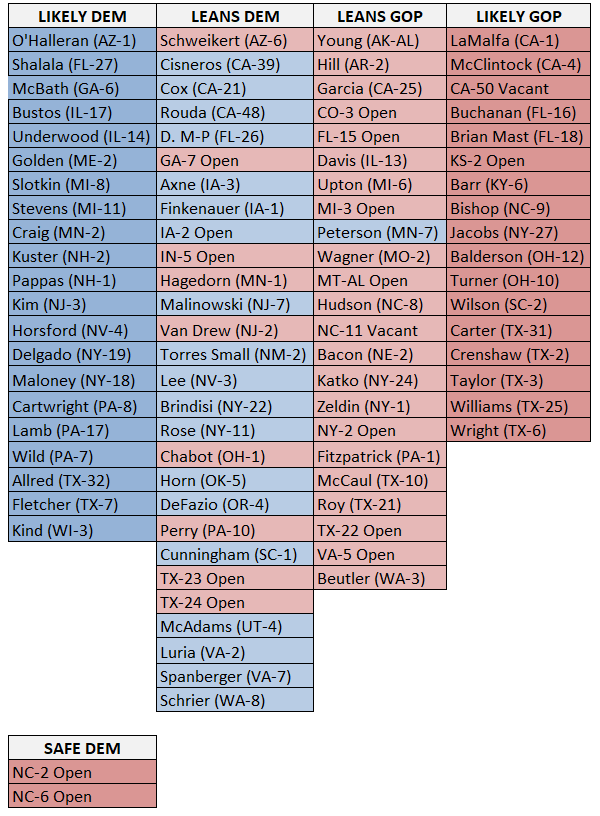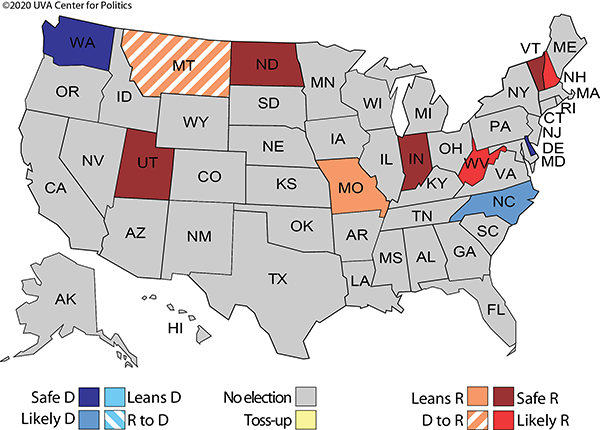|
Dear Readers: Due to popular demand, we decided to release a final pre-election Sabato’s Crystal Ball: America Votes webinar. We will be going through our picks for the election. We’ll also hear from Rob Griffin, the research director of the Democracy Fund Voter Study Group, about the demographic changes we are likely to see in the electorate tomorrow and into the future, as well as how we should interpret the exit polls tomorrow evening. We will be releasing this edition on our YouTube channel by 2 p.m. eastern. Just visit our YouTube channel, UVACFP, then (or whenever you want), and look for Episode 12 of the Sabato’s Crystal Ball: America Votes webinar. The direct link will also be available on the Center for Politics’ Twitter account (@center4politics) as soon as it is posted later today. — The Editors |
KEY POINTS FROM THIS ARTICLE
— Our final Electoral College ratings show Joe Biden at 321 electoral votes and Donald Trump at 217.
— Democrats are narrow favorites to capture a Senate majority, 50-48 with two Toss-ups — the two Georgia races, both of which we think are likely to go to runoffs.
— We have Democrats netting 10 seats in the House.
— The only governorship we have flipping is Montana, which would be a gain for Republicans.
Table 1: Crystal Ball Electoral College rating changes
Table 2: Crystal Ball Senate rating changes
Table 3: Crystal Ball House rating changes
Table 4: Crystal Ball gubernatorial rating changes
Map 1: Final Crystal Ball Electoral College ratings

Map 2: Final Crystal Ball Senate ratings

Map 3: Final Crystal Ball House ratings

Map 4: Final Crystal Ball gubernatorial ratings

Our final ratings
Is it possible that Donald Trump will win a second term as president?
Yes.
Do the data point to that happening?
No.
As we survey the political landscape a day before the election, we see a race that has largely been steady. Even before he was the Democratic nominee, Joe Biden seemed like the strongest potential challenger to Donald Trump. Perhaps that said more about the Democratic field than Biden himself, and he is hardly an inspiring candidate, but the former vice president has been able to bring together the Democratic Party’s warring factions — at least for now — and keep the focus of the election on the sitting president. A worldwide pandemic challenged Trump’s mettle — and he is in a considerably weaker position because of it.
We have kept looking for indicators that the president was catching up. It is likely the case that the president was in worse shape in the aftermath of the first debate and his hospitalization for COVID-19 than he is now, but it’s really just a question of the size of his deficit. Both our Democratic and Republican sources generally see Biden as a strong favorite to surpass the requisite 270 electoral votes to win.
Polling released over the weekend provided a few bright spots for Trump, particularly a Des Moines Register/Mediacom poll conducted by respected pollster J. Ann Selzer showing Trump up a surprising 48%-41% in Iowa. A similar poll released four years ago proved a harbinger of Hillary Clinton’s weakness with white voters in small cities and rural areas across the Midwest.
However, there were plenty of other surveys over the weekend from other pollsters we respect that told a different story, a story that has been consistent throughout the campaign — Biden is polling markedly better with whites compared to Clinton’s performance, and he has built durable leads in the key states of Michigan and Wisconsin, and a smaller but seemingly real edge in Pennsylvania.
Is it possible that Selzer and some other polls that have been good for Trump are right, and the others are wrong? Sure. Among our sources — and among us — there is a persistent worry that pollsters have simply misconstrued the white vote. In this scenario, the president’s strength among white voters would either be undiminished from 2016 and/or a wave of newly registered or activated Trump voters would come out of the woodwork Tuesday to save the president. This may be real, and the product of a carefully executed plan hatched years ago, or it may be wishful thinking by the president’s supporters.
One politically experienced friend of the Crystal Ball subscribes to this theory and believes in his gut that Trump will win. He also said that if he were in our shoes, he’d have to pick Biden too — because that is what the data suggest is the proper handicap. One doesn’t need to come up with a theory of hidden voters to believe Biden is the favorite. That’s just where the data lead, in our judgment.
Others will come to different judgments. If theirs is right and ours is wrong, we’re sure we’ll hear from them!
With that, let’s unveil our final handicapping of the Electoral College, Senate, House, and governors.
THE ELECTORAL COLLEGE
Throughout much of October, we had 290 electoral votes at least leaning to Joe Biden. That includes all of the states that voted for Hillary Clinton (232 electoral votes), plus Trump-won Arizona, Michigan, Pennsylvania, and Wisconsin in addition to the single electoral vote in Nebraska’s 2nd Congressional District. In the end, we did not see a reason to shift any of these electoral votes back to Trump. Pennsylvania is probably the state we feel the shakiest about. If Trump were to win the state, we suspect it would be because of even bigger margins in the state’s white rural and small town areas combined with a weaker-than-expected Democratic margin in Philadelphia. (While some projections of Trump winning 20% or even 30% of the Black vote are very unrealistic, he may do a little bit better than 2016 among nonwhite voters in aggregate.)
Note, though, that if Biden can win the Clinton states plus Arizona, Michigan, NE-2, and Wisconsin, he could afford to lose Pennsylvania. But that would be an agonizingly close election.
If Biden does carry these 290 electoral votes, and only these, he would be fine to win, but his victory might be in doubt tomorrow evening. That’s because the vote counts in some of these states — most notably Pennsylvania — could take a while to complete.
So if Biden wants an impressive victory on Election Night, he needs more than just these states. We should know a lot about the vote counts in a number of other big, competitive states on Election Night: Florida, Georgia, North Carolina, Ohio, and Texas. If Biden wins just one of these states, we think it would be indicative of him getting north of 300 electoral votes and a clearer victory on Election Night.
We do favor Biden in a couple of these states, but perhaps not the ones you might think.
If one goes by the polls, Biden should be favored in Florida, albeit only by a little. Yet we have seen the Democrats (and even the polls) come up short in the Sunshine State so often, including in the Democratic wave year of 2018, that we needed unmistakable signs to pick them there this time. We just don’t see those signs in this complex state with lots of moving parts. Therefore, we’re picking Trump in his adopted home state of Florida.
Team Trump, beware of the Crystal Ball’s kiss of death in Florida: We have to admit that our record in Florida is poor. We have erred in the state four cycles in a row, missing the 2012 and 2016 presidential races and the 2014 gubernatorial and 2018 gubernatorial/Senate races. Such is the peril of trying to divine a state that is so perennially close (all of the aforementioned races were decided by roughly a point each time). If we could’ve come up with an excuse to keep Florida as a Toss-up, we would have. But we traditionally call each state so that we can present a complete Electoral College projection.
We also are picking Trump in Ohio, although we expect his margin to be much reduced from his big 2016 win. Perhaps 2020 will be to Ohio what 2008 was to Missouri: the death knell of a Midwest state’s bellwether status. If Ohio does not vote for the winner, it would be the first time since 1960 that it failed to do so. We also favor Trump in two other whiter-than-average places where he did well in 2016, Iowa and Maine’s 2nd Congressional District (even though polling has actually shown Biden leading in the latter).
We came closer than we ever thought we would to leaning Texas to Biden — amidst an immense turnout, this may finally be the year of Blue Texas. But we retain enough skepticism that we will keep it in the lightest possible shade of red. Yet we all know there will be a year relatively soon when Texas votes Democratic again.
All that said, we do now favor Biden, narrowly, in two of the key Sun Belt states: Georgia and North Carolina. We have been surprised by the level of Republican concern about Georgia, and Democrats are expressing surprising confidence about North Carolina, a state that has frustrated the party in recent years. Neither place is a certainty for Democrats, but a small bet seems worthwhile on the Tar Heel and Peach states.
If our projection comes true, Biden would win an Electoral College victory smaller than those of Barack Obama in 2008 and 2012, although it’s possible that Biden could simultaneously eclipse Obama’s 7.3-point win in the 2008 national popular vote.
Of course, as Democrats know all too well, the national popular vote is meaningful only as trivia.
THE SENATE
Let’s assume that Democrats flip seats in Arizona and Colorado and Republicans flip Alabama, outcomes we have long projected in our ratings.
In that instance, it may be that one can boil the race for the Senate down to three races: Iowa, Maine, and North Carolina. It seems likely that the party that wins two of those three will win a Senate majority, even if that majority is just a 50-50 one broken by a vice presidential tiebreaker.
Our final ratings show Democrats favored in two of these three races, so we see Democrats as narrow favorites for a Senate majority when combined with their party’s edge in the presidential race.
We have shown Maine state House Speaker Sara Gideon (D) narrowly favored over Sen. Susan Collins (R-ME) since September. Democrats were hoping that Gideon would build a bigger lead by the end, but the race remains very close and seems likelier than not to trigger a ranked-choice voting process that most expect will benefit Gideon.
We leaned Iowa to challenger Theresa Greenfield (D) a few weeks ago against Sen. Joni Ernst (R-IA), but since then, the numbers seem to have gotten better for Republicans in Iowa, so we’re going to pick Ernst along with Trump in the state. Do not necessarily assume Ernst’s four-point lead in the Des Moines Register/Mediacom poll — which we freely admit is helping to guide our handicap — is necessarily real, though: Operatives on both sides of the race wondered if the GOP edge in that survey was a bit inflated.
That leaves North Carolina, and the battle between the movable object, Sen. Thom Tillis (R-NC), and the resistible force, former state Sen. Cal Cunningham (D). Despite Cunningham’s late-breaking extramarital affair and consequent damage to his image, Tillis has remained a bit behind, and he is almost certainly reliant on Trump dragging him across the finish line. Because we slightly favor Biden in North Carolina, we also favor Cunningham, who if elected to the Senate would enter the chamber as one of the more damaged newly-elected members in recent memory.
One can see how close the battle for the Senate is — in our minds, it is coming down to North Carolina. However, there are plenty of other competitive races beyond those we mentioned.
Republicans hold out hope that Trump can come close enough in Michigan to get veteran John James (R) in range of Sen. Gary Peters (D-MI), although Peters (and Biden) remain favored in the Wolverine State.
There is a long list of Republican-held Senate seats that are all Democratic upset possibilities: Alaska, Kansas, Montana, South Carolina, and now Texas, where we are downgrading Sen. John Cornyn (R-TX) from Likely Republican to Leans Republican. Biden is a big enough threat to carry the state that Cornyn has to be feeling some heat, although our read of the statewide and congressional district-level polling is that there are a small number of Biden backers who will support Cornyn and a House GOP candidate down the ballot. It may be that Democrats score an upset in one or more of these second-tier states, but we are not picking Democrats in any of them.
Finally, there are the two races in Georgia, which we’re calling Toss-ups in anticipation of runoffs. The Georgia special, an all-party jungle primary, seems guaranteed to go to a runoff as it’s not practical for anyone to get to 50%. In the late going, and as Republicans have seemingly lost ground in Georgia, some in the GOP are worried about Sen. David Perdue’s (R-GA) ability to hold challenger Jon Ossoff (D) under 50%. We see a runoff as the likeliest outcome even if Biden carries the state.
Between two possible runoffs in Georgia, a potential ranked-choice vote allocation in Maine, and the vicissitudes of the vote count in some states, there may be lingering question marks about Senate control after Nov. 3.
THE HOUSE
Operatives on both sides of the battle for the House agree that the Democrats will hold the House of Representatives, but they also marvel at both the size of the battlefield and the seeming fact that neither side has truly put away their most obvious targets.
While Republicans remain confident that they will knock off several Democratic incumbents in districts that Donald Trump carried by decent-sized margins in 2016, the general consensus is that only a single Democratic incumbent is a clear underdog: Rep. Collin Peterson (D, MN-7), the long-tenured chairman of the House Agriculture Committee who holds a district that’s much more Republican than any other held by a Democrat. We are giving the benefit of the doubt to other incumbents in our final picks, but don’t be surprised at all if several other Democratic incumbents, such as Reps. Xochitl Torres Small (D, NM-2), Kendra Horn (D, OK-5), or Max Rose (D, NY-11), end up losing. If one or more loses, it will be a victory for Republican efforts to tie these incumbents to national Democrats on issues such as energy production and law enforcement.
We also are giving some endangered Republicans a halting nod in districts where Donald Trump seems very likely to lose significant ground, such as Reps. Ann Wagner (R, MO-2) and Don Bacon (R, NE-2). Despite a poor national environment, Republicans are holding their own in some of their most vulnerable seats; for instance, both sides agree that the open seat in TX-23, a perennially competitive, majority-Hispanic district that runs from El Paso to San Antonio, remains a dogfight even though many assumed it’d be a sure Democratic pickup when Rep. Will Hurd (R) retired after barely surviving 2018.
Overall, we see House Democrats picking up some traditionally Republican suburban districts where Trump seems likely to run behind his 2016 showing. That includes open seats in GA-7, IN-5, and TX-24. We also see a combination of strong Democratic challengers and slippage for Trump as endangering Reps. David Schweikert (R, AZ-6), Steve Chabot (R, OH-1), and Scott Perry (R, PA-10). Rep. Jeff Van Drew (R, NJ-2) switched parties during the impeachment battle; now he appears to be a slight underdog.
Coming into the end of the campaign, we had 18 Toss-ups, and we have leaned them all: 11 to the Democrats, and seven to the Republicans. We are under no illusions that we will get all of them right. The playing field is large and there are a large number of close races. Overall, our ratings show the Democrats netting 10 seats from the 233 they currently hold (assuming Democrats hold a safe-seat vacancy), or an eight-seat gain from the 235 Democrats won in 2018.
THE GOVERNORS
We had only one Toss-up in the gubernatorial races, the open seat in Montana. It appears that the race between Rep. Greg Gianforte (R, MT-AL) and Lt. Gov. Mike Cooney (D) has tightened down the stretch, matching the state’s very competitive at-large House and U.S. Senate races (the presidential race seems surprisingly close as well). But ultimately we think the GOP is a better bet in all of the Montana races, so we’re pushing the gubernatorial race to Leans Republican.
Democrats are hopeful that state Auditor Nicole Galloway (D) can upset Gov. Mike Parson (R-MO), but our sense is that the incumbent is still ahead.
So it is Leans Republican in the two races we see as most competitive tomorrow, and don’t be shocked if the Democrats score an upset in one or both.
If our ratings hold, the Republicans would net a single governorship this year, giving them 27 and Democrats 23 as we head into a midterm cycle, when the vast majority of governorships are contested.
Conclusion
This is the 72nd issue of the Crystal Ball this year — the most issues we’ve ever published in a single year, and the year is not over.
At the very least, we can guarantee that readers have gotten their money’s worth — especially since the UVA Center for Politics, as a public service, does not charge anyone for the Crystal Ball.
Whatever happens, we’ll be back after the election to start wading through the results — and looking ahead to what’s next.
